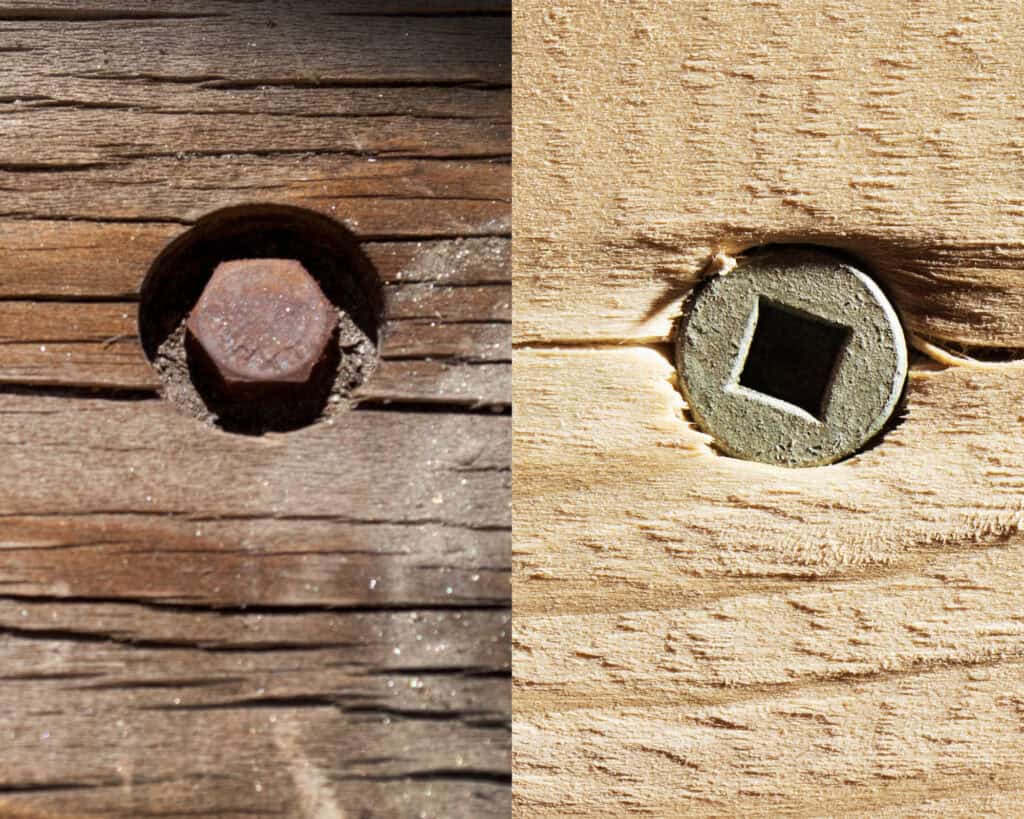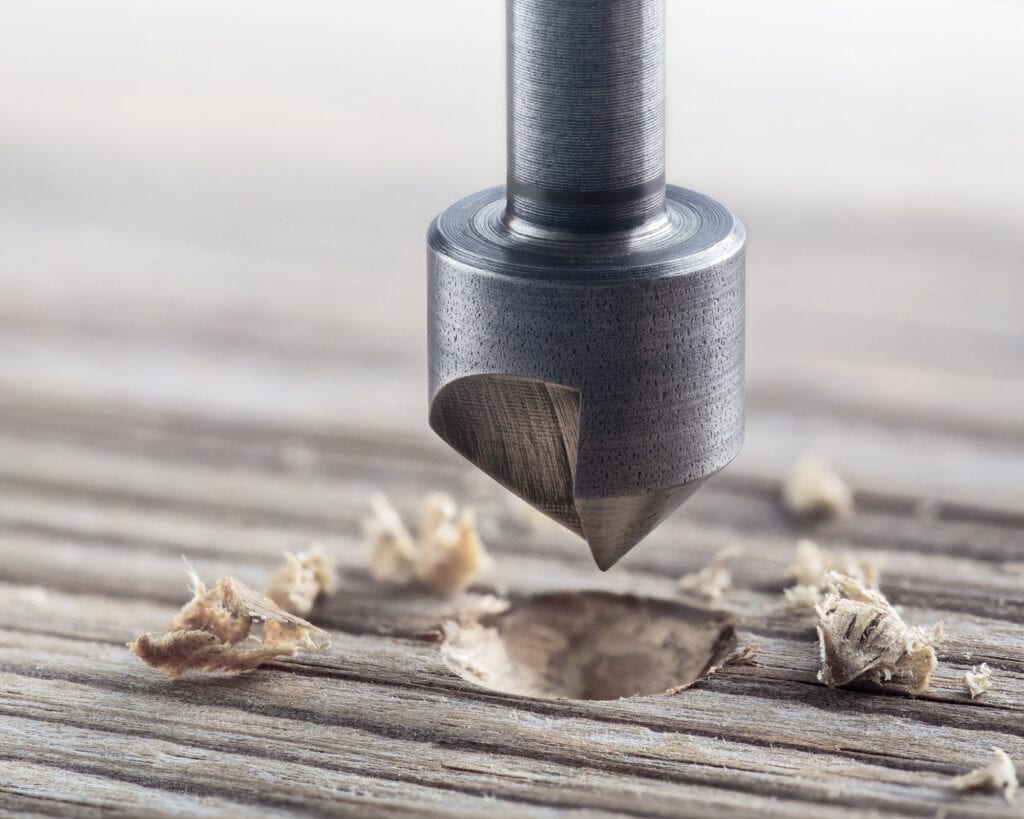
Counterbore vs Countersink?
In woodworking, metalworking, and even certain DIY projects, the quality and precision of your work can often depend on the smaller details. One such detail is how you choose to secure fasteners like different types of screws or bolts within the material.
While simply driving a screw into a surface might seem sufficient, there are advanced techniques that can improve both the functionality and aesthetic of your project. Two of the most common techniques used to achieve a cleaner and more professional finish are counterbore vs countersink which are two different hole types.
Although both techniques allow the screw or bolt head to sit below the surface, they offer different purposes and are not interchangeable. Each method has a specific purpose, with counterboring creating a flat-bottomed hole for screws with larger heads and countersinking creating a conical recess for tapered screw heads. These subtle differences can have a significant impact on the durability, load-bearing capacity, and final look of your project.
Whether you’re constructing a piece of furniture, installing cabinetry, or working on mechanical components. Understanding the difference between counterbore vs countersink is essential. In this guide, we’ll explore the key distinctions between these two type of hole techniques. Discuss their specific uses and provide tips on when to use each method to enhance both the strength and appearance of your work.
By the end of this article, you’ll have the knowledge to choose the right technique for your next project. Helping you achieve a more professional result every time. Let’s get to it!
Understanding Counterbore and Countersink
1. What is a Counterbore?
Counterbored holes are cylindrical flat-bottomed holes that are drilled into a material to allow the head of a screw or bolt to sit flush with or below the surface. The counterbore hole is larger in diameter than the screw or bolt, providing space for the fastener’s head.
- Best For: Situations where you need the screw or bolt head to be recessed and flush with the surface of the material, often in cases where the assembly will be subjected to heavy loads.
- Tip: Counterboring is commonly used in woodworking and metalworking when the flat head screw or bolt head must be hidden or covered for aesthetic or safety reasons.

2. What is a Countersink?
A countersunk hole is a cone-shaped hole cut into a material, allowing the head of a countersunk screw or bolt to sit flush with or below the surface. Countersinking is used when the fastener needs to be level with the surface or when a tapered screw is required.
- Best For: Applications where the head of the screw or bolt head must sit flush with the surface, such as in cabinetry, furniture making, and metalworking.
- Tip: Countersinking is ideal for projects where a smooth, even surface is needed, or where screws will be visible and need to be flush with the surface for aesthetic purposes.
Key Differences Between Counterbore and Countersink
Hole Shape and Function
The main difference between counterbore and countersink lies in the shape of the hole and the type of fastener used. A counterbore creates a flat-bottomed cylindrical hole with a larger diameter for the fastener head. While a countersink creates a conical shape hole for tapered screws.
Applications and Use Cases
Counterboring is often used in heavy-duty applications where the fastener head must be recessed for a flush finish, and it’s frequently seen in construction, manufacturing, and mechanical applications. Countersinking is more common in woodworking, cabinetry, and metalworking, where a flush or slightly recessed screw head is desired for a smooth, finished appearance.
Tooling and Equipment
Both counterbore and countersink require different types of tools. A counterbore typically uses a forstner bit that will create a flat bottom hole. While a countersink uses countersink screws or countersink bit to create a conical hole. It’s essential to choose the correct tool and type of screws or bolts for the job to achieve the desired result. Make sure your size of the hole is appropriate for your screw of bolt head.
Visual and Structural Considerations
Counterboring allows for the addition of a plug or cap to cover the fastener head, which can be useful in applications where the fastener needs to be hidden. Countersinking, on the other hand, provides a neat, clean appearance where the screw or bolt head is visible but flat surface.
When to Use Counterbore
- Heavy-Duty Applications: Use a counterbore when working on projects that require strong, recessed joints, such as in furniture or mechanical assemblies.
- Aesthetic Needs: When you want to cover or hide the fastener head for a clean, finished look.
- Safety Considerations: Ideal for applications where protruding screw heads could cause injury or interfere with moving parts.
When to Use Countersink
- Flush Finish: Use a countersink when the fastener head needs to be flush with the surface for aesthetic or functional reasons.
- Woodworking and Cabinetry: Ideal for projects where screws are visible and need to be level with the surface.
- Metalworking: Commonly used in sheet metal work where a smooth surface is required.
Key Features to Consider
Material Compatibility
When choosing between counterbore and countersink, consider the material you’re working with. Some materials may require specific tools or techniques to achieve the best results.
Screw/Bolt Type
Ensure that the fastener you’re using is compatible with the hole type. For example, countersunk screws are necessary for countersinking, while flat-bottomed screws or bolts are suitable for counterboring.
Aesthetic Preferences
Consider whether the fastener head will be visible and if you prefer it to be flush, recessed, or hidden entirely.
Load-Bearing Requirements
Counterboring is often preferred for load-bearing applications, while countersinking is better suited for aesthetic finishes.
Common Mistakes to Avoid
- Using the Wrong Tool: Make sure to use the correct bit for either counterboring or countersinking to avoid damaging the material or achieving poor results.
- Incorrect Depth: When counterboring or countersinking, ensure during the drilling process that the hole is drilled to the correct depth based on your material thickness. This will help in avoiding a protruding or excessively recessed fastener.
- Overlooking Material Type: Different materials require different approaches. Make sure your technique is suited to the material you’re working with.
Before you go…
In any project, the finer details can make a world of difference in both the final outcome and the longevity of your work. By understanding the distinct roles of counterbore and countersink. You can elevate your craftsmanship to new levels. Ensuring that your fasteners serve not only their functional purpose but also contribute to the overall aesthetic and integrity of the build.
Counterboring is your go-to solution for heavy-duty applications where strength and a clean finish are required. It allows for the screw or bolt head to be recessed into the material, hidden from view, and sometimes capped for a flawless finish. This method is ideal when safety, durability, and a smooth surface are priorities, such as in furniture construction or mechanical assemblies.
On the other hand, countersinking is perfect when you need fasteners to sit flush with the surface. Especially for a sleek and polished look in woodworking, cabinetry, and metalworking.
By carefully considering factors like material type, load-bearing requirements, and aesthetic preferences. You can choose the technique that best aligns with your project’s needs. Whether you aim for a fastener that’s discreetly hidden or one that blends smoothly into the surface. Mastering the art of the different types of holes like counterboring and countersinking. This will give your work the professional touch it deserves.
Armed with this knowledge, you’re now ready to tackle your next project with confidence. Ensuring both the form and function of your fasteners meet the highest standards. Let’s get to it!!!!
Understanding counterbore and countersink can improve the look of your woodworking projects. For more woodworking basics, check out How to Cut Thick Wood with a Circular Saw, or see our Best Screws for Plywood guide to secure your projects properly.
If or when you choose Counterbore vs Countersink and what is best for your future projects. I’d love for you to tag us on Instagram so I can see your really DIY projects finished results!
COZY HOME, COZY RECIPES:
Every cozy home deserves amazing recipes, and it’s even better when those recipes are both delicious and healthy. Our goal is to provide tasty meals that are easy to make, regardless of your skill level.
Fast, easy meals leave more time for fun activities, making your home a hub of joy and good food.
CONNECT WITH US:
As always, we love hearing about your experiences with our “Counterbore vs Countersink: Understanding the Differences and Uses”. Reach out to us through our social channels. Any questions you have, we’re here to answer.
Stay updated by joining our newsletter, offering a monthly dose of new recipes and a first look at upcoming projects.
MORE COZY KITCHEN RECIPES:
If you’re hungry for more, explore our collection of Cozy Kitchen Recipes. Another healthy favorite is the “Sausage Potato Veggie Bake.” Find these recipes and more here.
DIY RESOURCES:
For additional resources, check out our DIY Tutorials, offering a wealth of information to enhance your home improvement skills.

